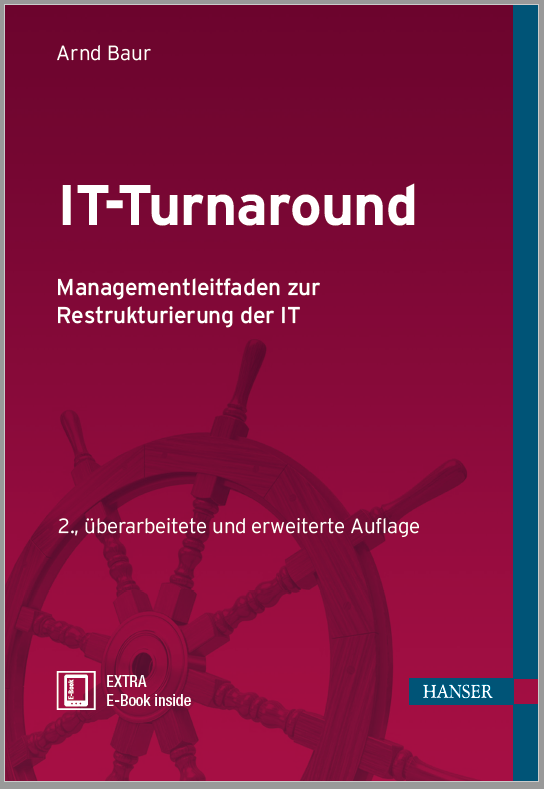What should an IT manager who has run into trouble and been asked to “clean up” IT should do?
What does a CIO (Chief Information Officer) do when he takes office find a company IT in which employees are demotivated, in danger of failing projects and, moreover, perhaps the IT costs are getting out of hand? How can a board responsible for IT recognize a crisis in IT and understand what special prerequisites, fields of action, processes and pitfalls accompany a turnaround in the IT sector?
Objective of the book:
The IT Turnaround book provides assistance in these situations and explains the concept of the IT turnaround or IT restructuring.
IT restructuring is a set of tasks that can be used in the event of a troubled IT department of companies and/or in the context of restructuring (or turnarounds, refurbishments) of companies as a whole. The main aim here is to:
- quickly identify the most threatening deficits in IT (e.g. existing IT risks/threats, excessive IT costs, emigration IT staff, lack of governance structures, lack of acceptance/standing of IT in the company, etc.)
- develop and implement immediate measures to stabilise the IT sector,
- to define the course for the recovery of the IT sector and to detail it in the form of a roadmap and
- turn the IT sector back into an effective and efficient part of the company in the medium term.
The book was rated by getabstract with 8 out of 10 points!
The book specifically emphasizes the aspects that experience has shown to be particularly important in crisis areas. With the special situation “IT crisis” the normal processes and the usual tools of IT management fade into the background. A different approach is needed, which takes into account the usually high need for action and the corresponding time pressure. In the shortest possible time, transparency about the state of IT must be established and appropriate measures must be taken. The focus is on pragmatism, focus and the rapid implementation of the identified improvement measures. In addition, the IT restructuring is parallel to the usual day-to-day business of IT (e.g. IT operation, user support, implementation of projects). This leads to an additional high burden on the persons involved.
Thematic focus in the book:
- Symptoms and signs: Identification of a crisis situation in IT
- Typical causes of IT crises
- Methods of corporate restructuring and their suitability for an IT turnaround
- Requirements for the CIO / IT manager in a crisis situation
- Tasks of top management in crisis management
- Emergency risk identification and crisis response measures
- Ways to standardize IT and reduce complexity in IT
- Cloud-based application strategies
- Assess the suitability of bi-modal structures in IT
- Prioritize and carry out digitisation projects
- Digitalization pressure in the event of crisis-ridden IT: Opportunities for CIOs to act
- Designing the “Retained IT Organisation” after outsourcing
- Turnaround of distressed IT projects
- Concrete levers to reduce IT costs.
- Determination of the appropriate IT manufacturing depth or the scope and expediency of outsourcing or Cloud services
- Treatment of the so-called shadow IT, i.e. of the software and hardware used in the departments of decentralized and often without the involvement of the central IT department
- Development trends for future-oriented IT areas
- Essential elements of IT governance
- Necessary processes between IT and departments or IT customers
- Sustainable implementation of changes through targeted change management
- Help you select external help for an IT turnaround
Further information on the book:
- Download the table of contents: IT turnaround content
- Order a book
- To the website of the Hanser-Verlag
Please recommend the book

